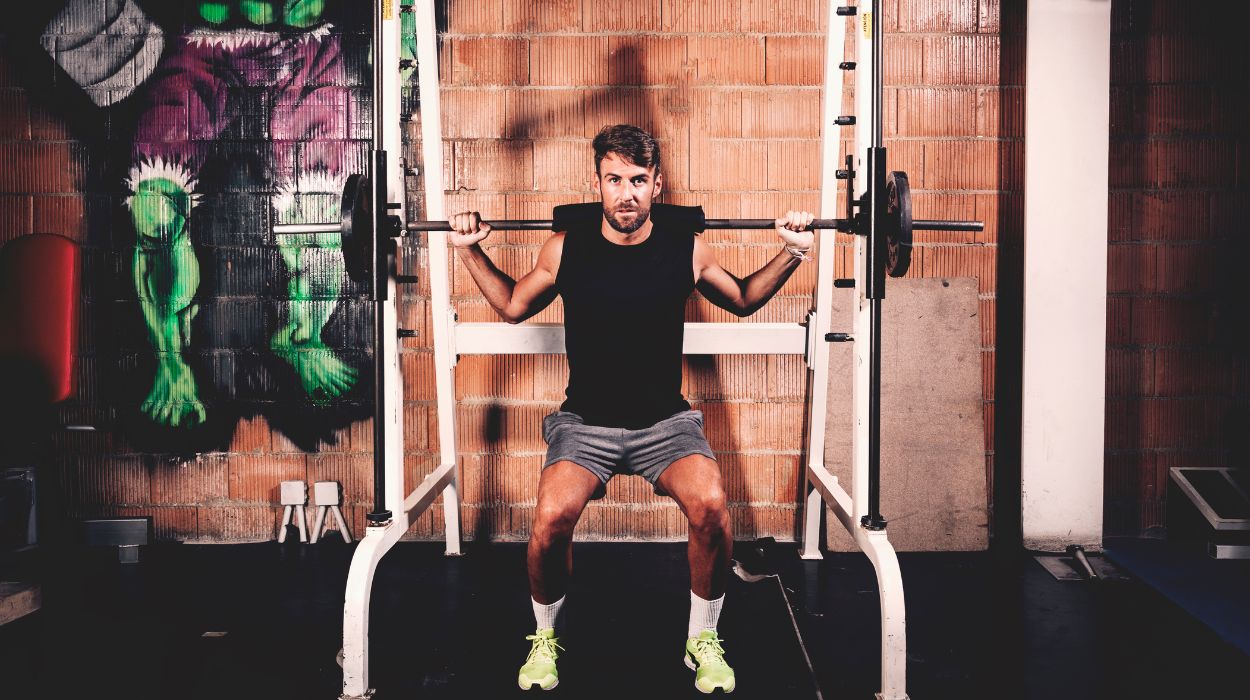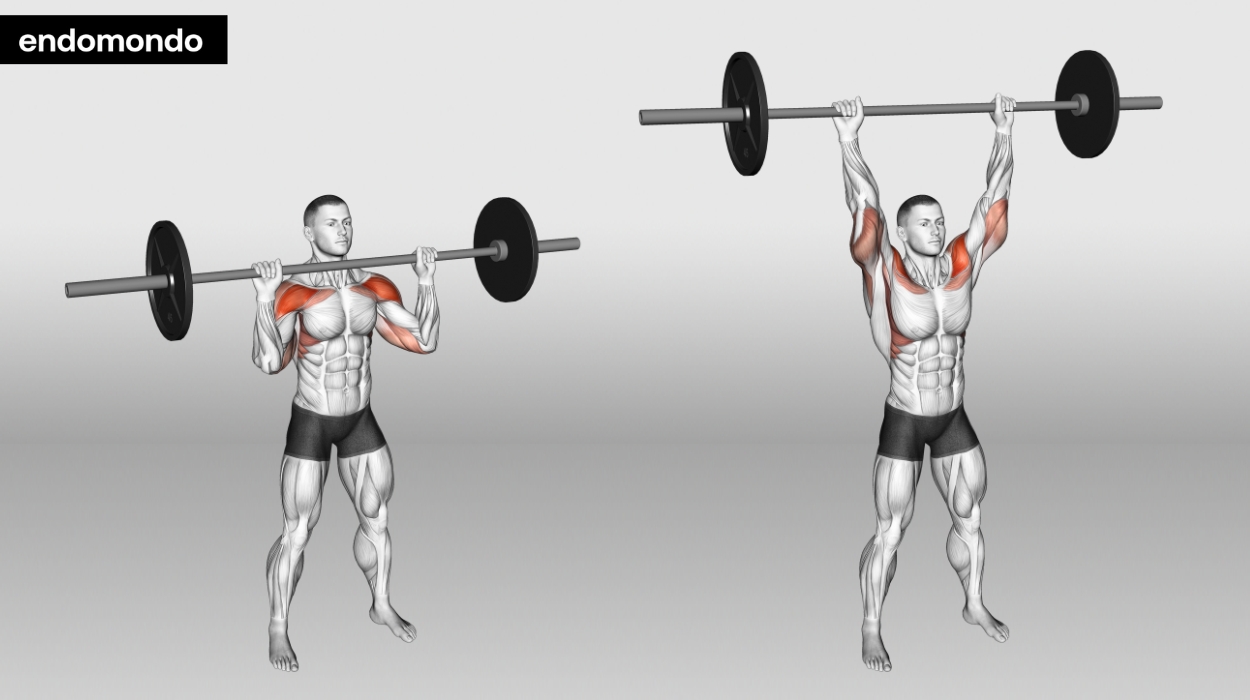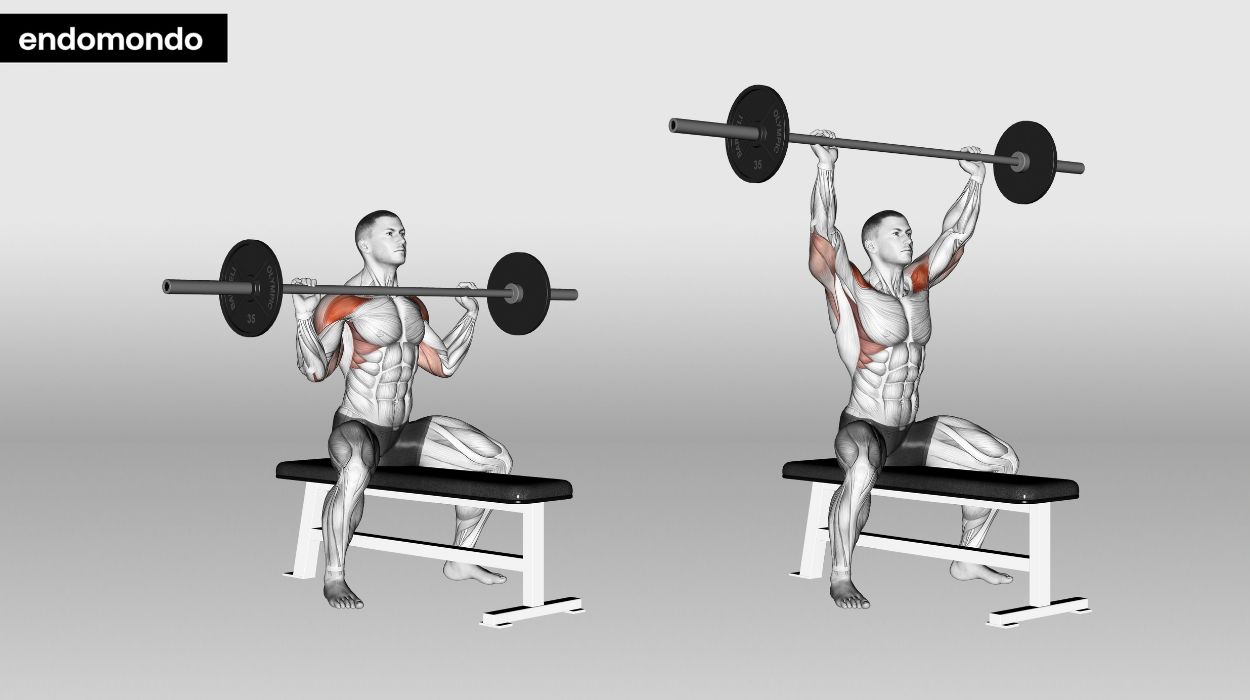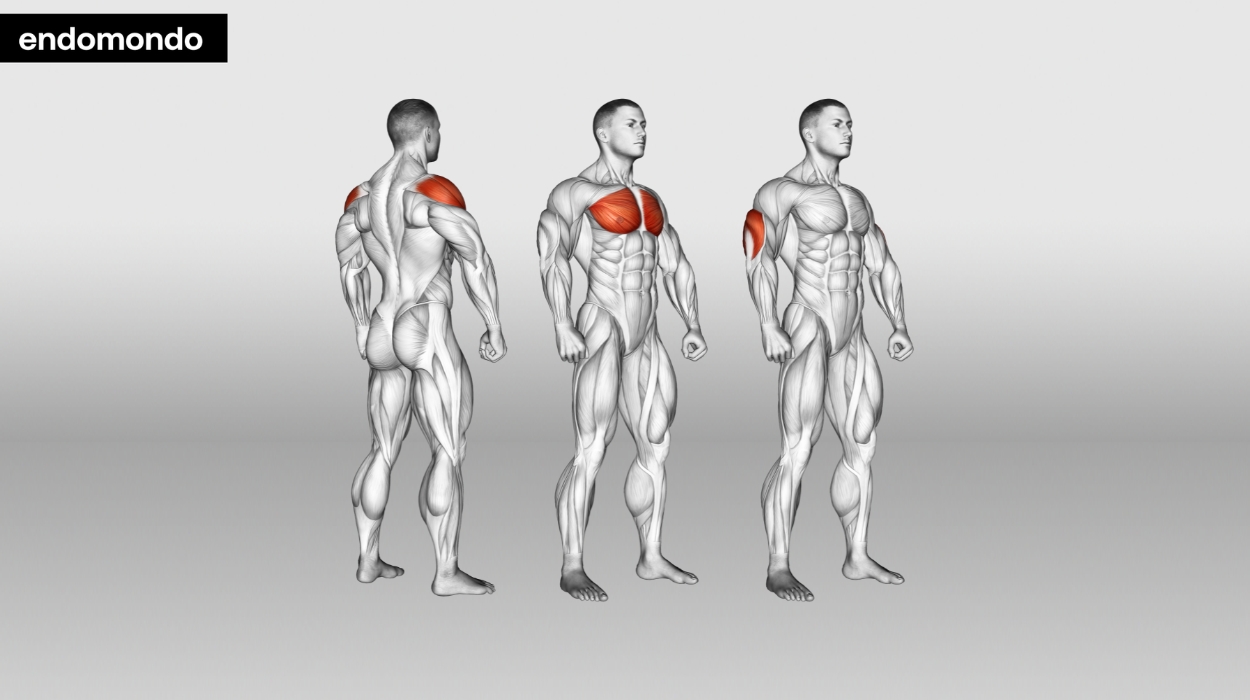
Functional strength training[1] involves doing compound exercises using multiple muscle groups. Functional exercises move your body in multiple planes of motion similar to daily life activities. For example, during a barbell overhead press, you push your arms upward over your head just like lifting a box onto your closet shelf.
Daily life activities require you to move in functional movement patterns. Challenging your body with dynamic exercises that require more than one isolated muscle group promotes improved functional task tolerance. Therefore functionally training your body helps you perform your life tasks better.
A proper technique in executing the barbell overhead press is essential to gaining its benefits. You may wonder how many repetitions and sets to perform during your workouts. Your exercise intensity depends on your fitness goals; there are different parameters whether you’re improving your conditioning or building strength.
Instructions and options to perform a barbell overhead press are detailed below.
How To Do The Overhead Barbell Press
- Decide if you’re doing a standing or seated barbell overhead press.
- Prepare your bar and workout area.
- Use a hip-width stance for standing.
- Use an adjustable bench for a seated barbell overhead press.
- The hand grip is pronated, palms facing forward, and slightly wider than shoulder-width on the bar.
- Elbows are front-facing and must stay under the load through the press.
- Inhale before the movement.
- Exhale, engaging your core, then press the bar upward directly overhead and align with shoulders and hips.
- Lock out your elbows to finish the press.
- Return the bar to the starting position with control.
How To Do Standing Barbell Overhead Press

The multiple muscles used when performing an overhead barbell, BB, and press traditionally make it a foundation exercise in strength training. Overhead pressing increases upper body strength specifically focusing on shoulder muscles while also utilizing other muscles for body stability. Learning the overhead press form is vital to performing it well.
Overhead press variations include standing or sitting with a barbell, using a Smith machine, or dumbbells. The bar position could be in front or behind the head and the bar grip may also change. The overhead press, also called the military press, is a great lift to increase shoulder strength.
Common standing overhead press mistakes to be aware of are letting your elbows flare outward or not having a wide enough stance. Following technique guidelines can help minimize injuries when lifting weights. We provide step-by-step instructions for how to overhead press in the standing position with the bar in front; this is to ensure you can do them well and avoid injury.
Prepare Your Bar
Choose the weights you want for your session. Begin with a lighter weight on the bar for your warm-up. Ensure the bar is set at shoulder height for easier transition off the rack. Stand in front of the rack and prepare to take the bar off the rack at shoulder height.
Start In Front Rack Position
Stand with your hands gripping down-facing or pronated on the bar[2] and placed just wider than shoulder width apart. Pick up your bar, take a couple of steps back away from the rack and place feet about shoulder-width apart. The bar rests at the front of your shoulders and on the heels of your palms. Elbows facing forward not flared out.
Take A Deep Breath And Brace
Standing with the bar, your back upright, and your chest lifted keep your head in a neutral position and fix your gaze forward. Next, take a deep breath through your nose; you will exhale through your mouth to engage your abdominal muscles and support your press.
Exhale And Press The Bar Up
As you exhale, tip the head back slightly and press the bar upward forcefully overhead; perform in a straight line until your arms are extended and locked out. As the bar passes your head, realign the head and neck to the neutral position. At the top, the bar should be aligned over your shoulders and hips, and feet planted on the floor.
Lower The Bar
Lower the bar back to your starting position by bending your elbows and controlling the bar’s descent. Finish at the front of your shoulders and prepare for your next lift.
Tips
Some suggestions to improve your standing overhead press include:
- Work on increasing your scapular stabilization muscle strength, such as the rotator cuff and serratus anterior.
- Improve your abdominal and back muscle strength to better support your press-up.
- Increase your shoulder mobility to allow optimal movement and alignment.
- Stronger arm muscles, like the triceps, will aid your press work.
- Focus on your form or body alignment in every phase of the exercise.
How To Do Seated Barbell Overhead Press

The seated overhead press is set up differently than a standing barbell shoulder press. It requires you to sit upright or slightly reclined on a bench to perform the exercise. The focus is on the upper body muscles when pressing weight overhead from a sitting position; the lower body is minimally active.
If using a slightly reclined bench, the muscle use at the shoulder is altered. This is because the angle of motion is a bit in front of the shoulders.
The bench-supported option for the overhead shoulder press provides trunk stability. So, less core activation is required when using a bench with back support. If you prefer to have a more active core when lifting, the unsupported seated barbell press is the winner.
A strategic option to vary your workouts if you are a competitive bodybuilder[3] – alternate weekly between standing and seated overhead presses.
Prepare The Bench Area
Decide if you plan to do a supported bench with a back, seated overhead press, or unsupported using a flat bench. Set up your bar placing it about shoulder height on the rack while standing. Choose the weights you would like to use and load them on the bar. Set your bench just under a rack so that you can lift the bar off overhead.
Grip The Bar And Un Rack
Sit down on the bench with feet flat on the floor. Grip the bar in a pronated grip just wider than shoulder-width apart. Tuck your chin in, lift the bar off the rack and prepare to lower.
Lowering The Bar
Inhale as you lower the bar. Do so in a controlled motion stopping at the top of the chest in front of your shoulders. Be careful to keep the bar balanced between both hands and arms.
Exhale And Press
Exhale to engage your core as you press the bar upward to the overhead position; then lock out your elbows. Your head should be in a neutral position and your arms aligned over your shoulders and hips.
The Finish
Lower the bar and repeat the overhead barbell press for the desired amount of repetitions. Once finished with your final overhead press-up, carefully rerack your bar above you.
Tips
In addition to the standing tips provided above, practice and repetition will help you perform seated overhead presses better. Here we offer some tips that may assist your workouts.
- Monitor your elbow alignment so they remain under your weight during your press to minimize strain on the shoulders.
- Be aware of your neck and back position when not using back support.
- Consider other options for overhead lifts if there is no rack available; such as using dumbbells, kettlebells, or machine overhead shoulder press for safety.
- Work on improving your back mobility since that can alter your seated press movement and alignment.
Barbell Overhead Press Benefits
The barbell overhead press has been used to measure entire body strength[4] for decades. This is due to the muscle action and power needed to perform them. Currently, BB overhead pressing may be used as training for athletic events or specific sports; it’s modified for use in a rehabilitation setting or just part of your regular workout to increase shoulder strength.
Shoulder presses are a smart choice for your workout routine if your goals include getting bigger shoulder muscles or increasing your upper body strength. They are also beneficial if you want to improve your functional tolerance for daily life or recreational activities. Athletes acquire benefits such as strength and power by performing an overhead press shoulder work. Let’s look further into press perks.
Increased Strength
Research indicates that shoulder pressing exercises improve muscle strength.[3] Resisted overhead shoulder press increases the amount of force on your shoulders, resulting in increased shoulder muscle strength. The multiple muscle actions that occur during an overhead press demonstrate similar force needed to handle sports and daily life activities.
Overhead press work is especially beneficial for athletes whose events require upper body strength. Sports like football or occupations such as construction workers who regularly lift overhead would be beneficiaries. The shoulder press is used in rehabilitation settings as well to assist patients with overhead reaching for daily tasks such as putting dishes in the cupboard.
Improved Motor Control And Coordination
Overhead press exercises encourage improvement in motor control and coordination.[4] The shoulder joint motion and muscle activity happening when you press overhead engages much of the upper body. Shoulder presses coordinate the entire chain of movement from the trunk through the shoulders, arms, and hands; this makes them a functional exercise.
Training your body in functional patterns aids coordination and motor control. Overhead shoulder press is one of several functional training activities that support daily life activities.
Enhanced Power
Power is sought after for numerous activities such as weightlifting, running, and jumping activities. Enhancing power[4] through overhead lifting is a foundational method of training regimens for athletes and fitness enthusiasts alike. The ability to quickly propel your body for specific sports is essential.
Upper body power is vital for swimmers, gymnasts, and those engaging in racket sports. Those who work with large machinery such as laborers would also benefit from overhead pressing exercises.
Common Mistakes To Avoid
Improper weightlifting technique can lead to injuries which is not your ultimate goal. Maintaining proper form during lifting exercises is vital to activate the correct muscles you intend to work. Despite your best intentions, you may perform overhead presses incorrectly. There are some common mistakes people make that you could avoid if you are aware of them.
The list below provides a glimpse into common overhead barbell press mistakes.
- Incorrect bar grip width.
- Allowing your elbows to flare outward.
- Not having a wise enough stance or base.
- Not straightening elbows to the lockout position at the top of the press.
- Pressing the bar too far forward or behind your body.
- Over-arching your lower back during the lift or on the completion.
- Not returning your neck position to neutral once the bar has passed your head.
Overhead Press Precautions And Risks
There are things you should consider when lifting weight overhead to be safe and limit potential injury. An important aspect is to make sure you are using a weight you can manage with proper form. You should be able to move your body in the range of motion required for an overhead press without weight.
Get clearance from a healthcare provider to perform overhead work if you have an injury or surgical procedure involving your shoulder. Resistance exercise overhead may be contraindicated for certain bone or joint conditions such as arthritis or osteoporosis. The potential for soft tissue injuries, such as rotator cuff or labral damage,[5] exists due to the mechanisms involved with overhead pressing.
The rotator cuff stabilizes the shoulder in the joint capsule. The joint is rimmed by the labrum, thus repetitive overhead resistance could injure those tissues. It is essential to learn proper lifting mechanics and have professional guidance with weighted workouts. If you encounter shoulder pain during or after lifting, consult with a healthcare professional.
Typical Pain Points And How To Address Them
Recurring issues with overhead lifting may be indicative of poor form or inadequate strength to perform your lift effectively. What can you do if you notice certain pain points repeating when doing barbell overhead presses? Troubleshooting specific problems is challenging so let’s look at some potential solutions.
- If you are unable to control the weight you choose to lift, that will affect your form. Poor form yields poor lifting results. Decrease your weight and focus on perfecting your form.
- Try using an alternative to the bar until you are stronger and able to perform overhead lifting with the correct technique. Do the barbell overpress with dumbbells to improve your lifting efficiency. Then return to using the barbell once you have sharpened your lifting process.
- Control and balance are essential for your overhead lift to properly execute and get the expected results. Weakness in your shoulder or core stabilization muscles will not provide the support required to press overhear properly and alter your technique. Work on strengthening your stabilization muscles to improve your muscular support during overhead lifting.
- If shoulder pain is reoccurring during BB overhead lift there may be a mechanical problem with your shoulder movement patterns. Movement issues can be caused by muscle imbalance, poor joint mobility, or faulty technique. If you have pain you should see a healthcare professional such as a physical therapist or orthopedic doctor.
How Much Should I Be Able To Overhead Press?
Numerous criteria are involved in determining how much you should lift such as your sex, age, and physical fitness level. Some of the factors that influence how much you should aim to lift include your purpose and goals for lifting. For instance, do you want to increase strength or improve the condition of your muscles?
First, you want to know how strong you are at the start of your workout to determine where to begin. You must learn your one-repetition maximum[6] or 1-rep max – the maximum amount of weight you can lift in one repetition to achieve muscle exhaustion. This formula decides what weight to use for your workouts to become stronger.
1-rep max is the foundation of resistance training exercise prescription. Make multiple attempts using heavier weights, with rest periods, until your muscles reach failure. Once that weight is known, the workout weight you use should be a range of 60% to 80% of your 1-rep max.
For example, you overhead press 100 pounds for your 1-rep max. Your workouts would consist of 3 sets of 8 to 10 reps at 60 pounds for 60% and 80 pounds for 80% – depending on if your goals are strengthening, bodybuilding, or conditioning. There is no one right answer for everyone.
Be sure to reach out to a trainer or physical therapist for more guidance.
Barbell Overhead Press Muscles Worked

Many muscles are involved when performing overhead presses. Some provide primary moving action or secondary assist, while other muscles act to stabilize during the exercise. A significant number of muscles are involved in a barbell overhead press though not rear deltoid or biceps muscles.
Primary muscle actions[2] of shoulder flexion and abduction, or forward and sideways arm raising are provided by:
- Anterior deltoid, or front shoulder muscle.
- Medial, or middle deltoid.
- Pectoralis major,[7] the upper portion of the chest muscle.
- Triceps brachii.
Secondary assisting muscle action[2] is provided by the scapular stabilization muscles:
- The rotator cuff muscles, specifically the supraspinatus.
- The trapezius and levator scapulae are neck muscles.
- Serratus anterior and rhomboids, muscles around your shoulder blades.
- Cervical and thoracic erector spinae muscles, muscles lining the spine of your back.
Trunk stabilization[2] muscles provide a supportive foundation during overhead pressing:
- Abdominal, or core muscles including transverse abdominis, rectus abdominis, and the obliques.
- Spinal erector muscles.
The compound muscle movements and joint actions required to execute an overhead press exercise are impressive. This is one reason why it is a standard for shoulder strengthening and functional training for athletes. The shoulder, upper back, chest, and arm muscles worked during any overhead press variation are utilized in everyday tasks.
Variations For Overhead Shoulder Press
Machine Overhead Press
Using a machine for the military press[3] provides a fixed forward bar placement and requires a more lateral or wide grip. The muscle action is different from using an overhead press machine than with a barbell because of the bar action. This overhead press variation provides more stability throughout the lift since you’re not balancing a free weight.
Dumbbell Overhead Press
Dumbbell and kettlebell overhead presses require slightly different muscle and joint actions since both arms move independently. One study noted that shoulder muscle activity was higher[7] when using kettlebells. Increased balance and coordination are required when using dumbbells or kettlebells versus a barbell or Smith machine; they’re a great option for home workouts too.
Back Overhead Press
Back overhead press can be performed standing or sitting and the bar is placed behind the head instead of in front of the shoulders. This approach increases spinal loading and activates the deltoid muscles[3] in the shoulders more than when pressing in front of the shoulders. The back overhead press is a great variation for your shoulder workout to engage and challenge muscles differently.
Push Press
The push press is a variation of a standing overhead press that improves upper and lower body power.[4] The knees are bent at the start versus straight with a standing barbell overhead press. So when you press overhead, your knees push to straighten at the same time.
Thus the exercise is named push press. The push press is an ideal exercise to build power and strength in the upper and lower body. Athletes, labor workers, or anyone who needs whole-body muscle strength and power would benefit from this press version.
Conclusion
Everyone can benefit from functional training exercises. Barbell overhead press or military press is at the top of the list for upper body strengthening. Since this exercise requires multiple muscles and joints to work simultaneously, it is essential to any workout or training program.
Overhead press works numerous shoulder, back, and arm muscles which are needed when doing most daily life activities. Increased strength, improved coordination, and motor control, plus increased power are all amazing benefits of performing overhead shoulder press exercises.
It’s essential to learn the proper technique and form to execute overhead barbell presses without incurring injuries.
Several variations of the overhead barbell press are beneficial such as behind the head or a slightly different version called a push press. Using dumbbells or kettlebells, or a Smith machine or seated overhead press machine are other options. Whether you’re a recreational or serious athlete or want to manage your home, overhead resistance training helps meet those goals.
Frequently Asked Questions
A few benefits provided by barbell overhead press are strengthening your shoulders, arms, and back muscles, and improving your motor control, coordination, and power.
BB overhead press is a difficult exercise because it requires multiple muscles and joints working at the same time. Good technique, strength, and stability are necessary to perform them properly.
Set up is different for standing versus seated BB overhead press. Use a rack to prepare your bar weight and proper height. Monitor your stance or sitting position keeping optimal alignment, and breathing, and control the bar throughout the lift.
The barbell overhead press is not bad for your shoulders provided you do not have a shoulder issue. It is not a good exercise if you currently or recently have had a procedure, injury, or condition involving the shoulders.
Resources
- Chiung ju Liu, Shiroy, D.M., Jones, L.Y. and Clark, D.O. (2014). Systematic review of functional training on muscle strength, physical functioning, and activities of daily living in older adults. European Review of Aging and Physical Activity, [online] 11(2), pp.95–106. doi:https://doi.org/10.1007/s11556-014-0144-1.
- Kroell, J. and Mike, J. (2017). Exploring the Standing Barbell Overhead Press. [online] ResearchGate. Available at: https://www.researchgate.net/publication/319607633_Exploring_the_Standing_Barbell_Overhead_Press.
- Coratella, G., Tornatore, G., Longo, S., Esposito, F. and Emiliano Cè (2022). Front vs Back and Barbell vs Machine Overhead Press: An Electromyographic Analysis and Implications For Resistance Training. Frontiers in Physiology, [online] 13. doi:https://doi.org/10.3389/fphys.2022.825880.
- Soriano, M.A., Suchomel, T.J. and Comfort, P. (2019). Weightlifting Overhead Pressing Derivatives: A Review of the Literature. Sports Medicine, [online] 49(6), pp.867–885. doi:https://doi.org/10.1007/s40279-019-01096-8.
- Edmonds EW;Dengerink DD (2014). Common conditions in the overhead athlete. American family physician, [online] 89(7). Available at: https://pubmed.ncbi.nlm.nih.gov/24695599/#:~:text=The%20overhead%20athlete%20is%20at,cuff%20tendon%20and%20labral%20impingement.
- Nuzzo, J.L., Pinto, M.D., Kazunori Nosaka and Steele, J. (2023). Maximal Number of Repetitions at Percentages of the One Repetition Maximum: A Meta-Regression and Moderator Analysis of Sex, Age, Training Status, and Exercise. Sports Medicine. [online] doi:https://doi.org/10.1007/s40279-023-01937-7.
- Michalina Błażkiewicz and Hadamus, A. (2022). The Effect of the Weight and Type of Equipment on Shoulder and Back Muscle Activity in Surface Electromyography during the Overhead Press—Preliminary Report. Sensors, [online] 22(24), pp.9762–9762. doi:https://doi.org/10.3390/s22249762.




